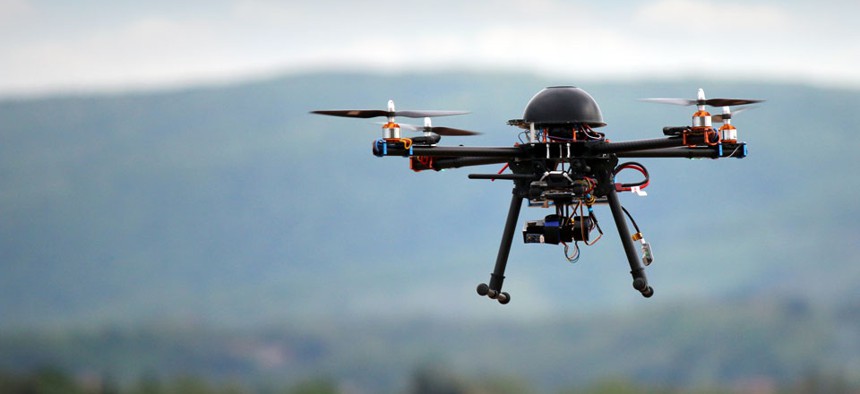'Ubiquitous As Pigeons': Imagining Life in the City of Drones

risteski goce/Shutterstock.com
An online installation asks us to accept an all-but-certain future of drones in cities, and to rethink our relationship to them.
What can a video of a cat riding a Roomba teach us about the future of drones in cities? For architect, artist, and futurist think-tank leader Liam Young, it's a lesson about how technology becomes not only democratized, but accepted.
“When Roomba first hit the market, people didn’t know what to make of them,” Young says. “All of that money for some weird vacuum? It wasn’t until someone put their cat on one and stuck it on the Internet that people started to relate. It was, 'Oh, look at everything I can do with this little robot.'”
It was in that spirit that City of Drones , Young’s latest drone-based art installation, was born. (He's done others .) It’s an online, interactive simulation that puts viewers in the "cockpit" of a drone flying through an imagined metropolis. (There will also be a live performance of the project at London’s Barbican Gallery in September.) The drone in the simulation has no mission other than to float through the cityscape, which the drone’s “computer vision” reduces to colored geometric shapes against a black sky. The viewer can navigate with a mouse to move in all directions. Swarms of other drones zip about above and below, reminiscent of The Fifth Element .

Though there’s no feline involved, Young hopes City of Drones will have, if you will, a Roomba-cat sort of effect: that a viewer might come to think more broadly, and freshly, of how drones might one day fit into civilian, urban life. “Eventually, they will be everywhere,” says Young. “In all aspects of our lives, as ubiquitous as pigeons. We need to start accepting that and thinking, what could drones be as enabling objects? Might we have a drone familial that follows us around? When we’re walking home at night from the Tube, can we call a drone to light our way?”
Personally, I found the digital cityscape, accompanied by a John Cale-composed “bleak tapestry of unholy noises, searing into the listeners’ ears” (which is how Cale actually described it in a press release), pretty ominous, and not quite square with Young’s earnest drone embrace. I couldn’t help but think of Skynet, given the absence of humans, or even recognizably human structures. But I did appreciate the aimlessness of the simulation. There is no crashing into things, no shooting, no losing. It’s not a game; there is no goal. City of Drones is purely an provocative experience, a limitless float through an abstract future.
You could also say it’s meant to de-stigmatize a technology most closely associated with “kill lists” and disquieting aerial surveillance—associations reflected by the 63 percent of Americans who think it would be “a change for the worse” if personal and commercial drones are permitted to fly through U.S. airspace. City of Drones asks us accept that all-but-certain future , and to rethink our relationship to it.
I certainly did think of drone-y news I’ve seen lately: bits about drones delivering pizza , a how-to on taking the perfect drone selfie , Martha Stewart’s glowing drone endorsement . Those, Young told me, are good examples of how drones are becoming democratized. But we should be thinking even more broadly, he says. How about drone taxis, drone buses, drone trash collectors, search-and-rescue drones, drones at the loading docks? Aside from being personal devices, drones could also be integral to a changing urban infrastructure.
And cities will have to adapt, from using new kinds of building materials (wi-fi and GPS permeability would be key), to installing landing pads and charging docks, to shifting a city’s very sightlines and dimensions. “When you have services coming at people from different cross-sectional heights, you can’t have a city planned solely around the ground,” says Young. “Buildings would have to adapt to the kinds of visual cues and parameters those drones are programmed to respond to.”
Whatever a real city of drones might look like, it’s still probably a ways off. Mary Cummings, Director of MIT’s Humans and Automation Lab, told me that the wind tunnels created by tall buildings would present a big challenge for urban drones. “Drones don’t do well in high wind,” she says. “It burns their battery life quickly, and it’s prohibitive to fly them very far. So we won’t be seeing too many in cities in the short term.”
Add that to the largest hurdle faced by drones-as-infrastructure: popular acceptance. To that end, Cummings applauds Young’s attempt to broaden the conversation. “There’s definitely a place for a new narrative, about what drones mean for our everyday lives,” she says. She points out, too, that people are working on the technologies that could make a City of Drones-type future reality. When unmanned flying cars (i.e., drones that can move people through the air and on the ground) goes mainstream, says Cummings, “Then cityscapes will start to change.” She predicts that’s perhaps 50 years away.
Which isn’t long. Hence the need to start thinking about accepting these changes, hence the dark, probing geometry of City of Drones. I only wish there'd been more cats.
( Image via risteski goce / Shutterstock.com )





